The Artist of Japan’s Bloody Era

By Eve Bigaj
Staff Writer
9/11/2020
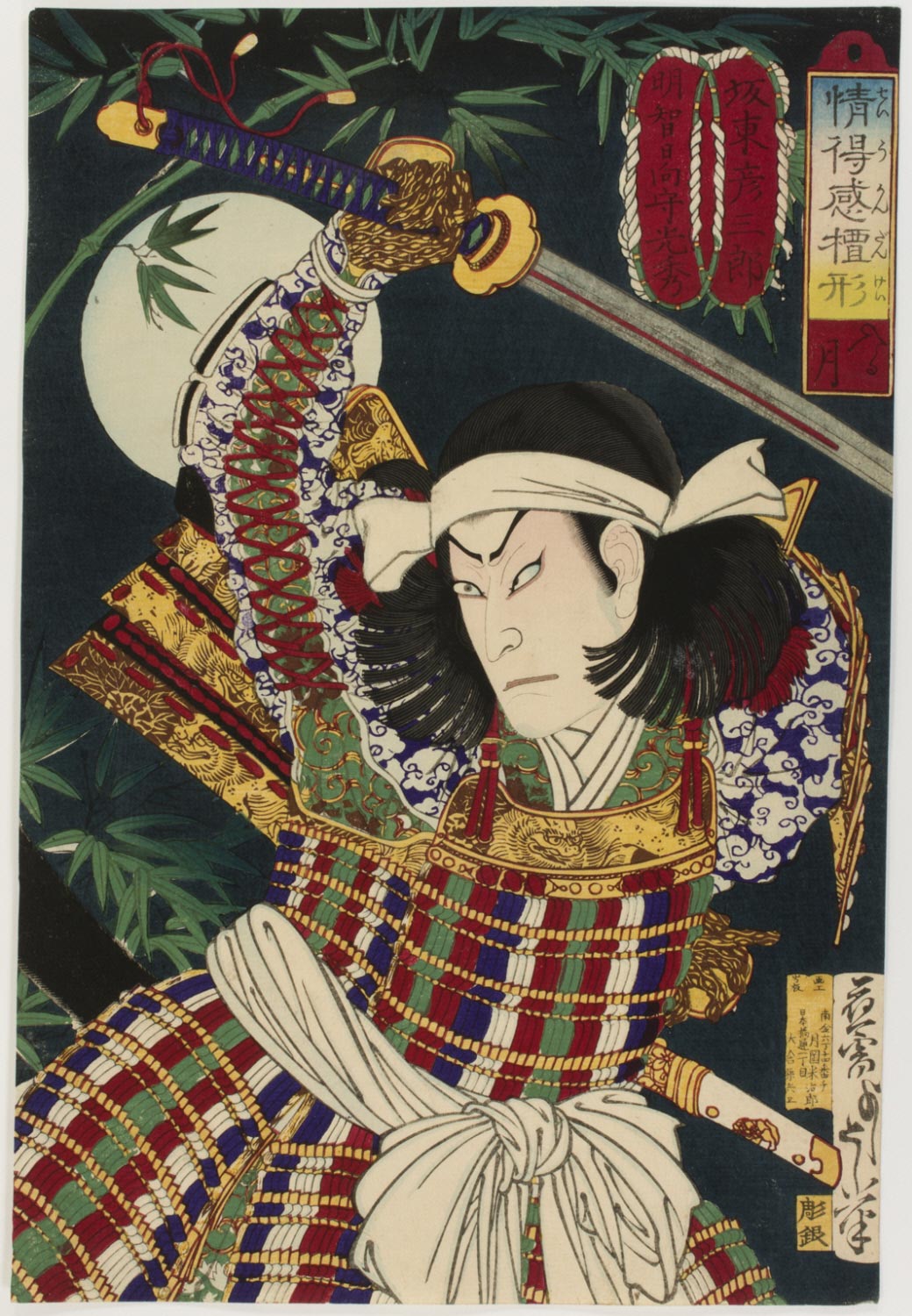
Setting Moon by Tsukioka Yoshitotshi
When Japan opened its borders to trade in the 1850s, inflation, epidemics, riots, murders, executions, and battles ensued. It’s easy to rattle off the sequence of events, tracing chains of political cause and effect, and lose sight of the human dimension of all this carnage. The imagination smoothes over the detail, removes individual faces, wipes out the actual blood.
The art of Tsukioka Yoshitoshi puts the blood back in the picture. He was there amidst it all, sketching in the execution grounds and battlefields. His prints zoom in on individual people – beheader as well as beheaded – and condense the spirit of his time. At this scale, his era’s violence attracts as much as it repels, leaving us face-to-face with our own capacity for bloodlust. It’s no wonder he called one of his series Biographies of Valiant Drunken Tigers; the warriors he depicts are as abhorrent in their bloodthirsty battle trance as they are admirable in their bravery. To look at his prints is to mourn the loss of life and to revel in it.
Yoshitoshi was born as Owariya Yonejiro in Edo (now Tokyo) on April 30, 1839. His father was a merchant wealthy enough to buy himself a place in a samurai family register – and hence a samurai title – from a financially struggling clan. Around the age of three, Yoshitoshi left home to live with his uncle; one of Yoshitoshi’s students would later claim that this was because Yoshitoshi disliked the mistress who moved in with his father at the time. At 11, he was apprenticed to printmaker Utagawa Kuniyoshi, whose studio specialized in depictions of heroic battle scenes.
In Kuniyoshi’s studio, the aspiring artist learned to draw human and animal figures from live models (a rather unusual practice, which Kuniyoshi had adopted from the West), perused his teacher’s art collection (which included Western engravings), and copied his designs, including gruesome prints like Byôkwansaku Yôyû Gazing at a Severed Head. He was building the foundation of his pictorial language. As was customary, he acquired his name as part of his artistic training; Kuniyoshi gave his student the name “Yoshitoshi,” including the character “yoshi” from his own name as a mark of lineage.

Byôkwansaku Yôyû Gazing at a Severed Head by Utagawa Kuniyoshi
Outside the studio, history was happening. In 1853, three years after the start of Yoshitoshi’s apprenticeship, Commodore Matthew Perry sailed into Edo Bay and demanded that Japan open its borders to trade with the US. The shogun (military leader) complied with Perry’s demand, and the following years saw massive inflation, epidemics, and riots. As if that wasn’t enough, in the years 1854-1855 Japan was hit by a series of devastating earthquakes.
When the 1855 Edo earthquake hit, Kuniyoshi was returning home from the kabuki theater. He had just watched a performance of the chilling tale of the hag of Adachi Moor, a cannibalistic witch who preyed on visitors to her home, especially pregnant women. By the time he made it home, his students (including the 16-year-old Yoshitoshi) had given him up for dead.
Sometime during the next few months (or perhaps that very night), Kuniyoshi suffered a stroke. Though he lived for another six years, he hardly made any more work after the earthquake…with the notable exception of multiple prints of the Hag of Adachi Moor, whose image seems to have lodged itself into his brain. As we’ll see, his student inherited the fascination.

Lifelike Dolls of the Hag of Hitotsuya at Adachigahar by Utagawa Kuniyoshi
When Kuniyoshi died in 1861, 21-year-old Yoshitoshi hadn’t had time to establish his own art studio. Meanwhile, unrest was reaching new heights. After the opening of borders, inflation and unemployment skyrocketed, and epidemics swept across the country. Hundreds of thousands died of cholera in 1858, twice as many of measles in 1862. Westerners were blamed for this and anti-Western sentiment soared; rebels began murdering foreigners. The murderers, in turn, faced execution. During these restless years, Yoshitoshi would join the crowds at execution grounds, continuing his teacher’s practice of sketching from life…or, in this case, death. There were many scenes to behold. A samurai plunged the knife into his bowels himself when ordered. Others were hanged or crucified, but good old-fashioned decapitation was favored for its simplicity. Plus, the severed head was a useful deterrent, easily exhibited and paraded around town; 123 severed heads were displayed in Edo between 1862 and 1865.
Yoshitoshi would join the crowds at execution grounds, continuing his teacher’s practice of sketching from life…or, in this case, death.
The fruit of all this observation can be found in the 1866-1867 series 28 Famous Murders with Verse, which Yoshitoshi completed in collaboration with another of Kuniyoshi’s old students, Utagawa Yoshiiku. (Each artist designed 14 of the prints.) The stories depicted in the series draw from history, popular legends, and the kabuki theater.
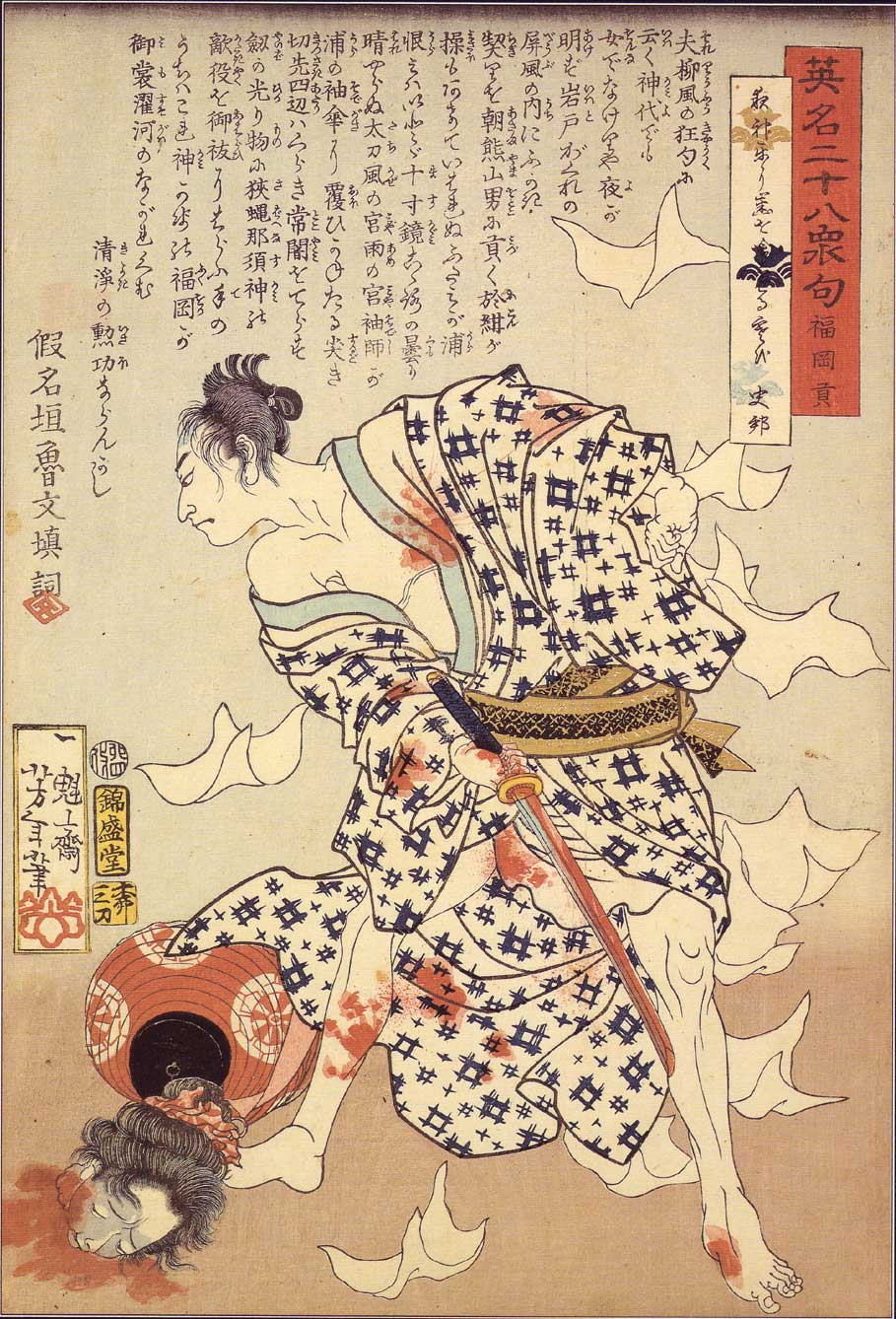
Fukuoka Mitsugi with Flying Papers, Severed Head by Tsukioka Yoshitoshi
Fukuoka Mitsugi with Flying Papers, Severed Head, one of the 28 Famous Murders, is based on the true story of the 1796 Aburaya teahouse murder, during which a 27-year-old doctor flew into a jealous rage, murdering three and seriously injuring six. The print captures the instant after the decapitation. Everything about the composition implies the recent struggle: the papers scattered during the altercation haven’t had a chance to descend, the killer’s expression is still frozen in fury. The red pigment mixed with glue spattered across his robe horrifies with its verisimilitude. Look more closely, and it only gets creepier: two of the bloodstains are handprints, left there by the woman whose head lies severed in a puddle of its own blood.
Yoshitoshi was hardly the first Japanese artist to represent violence. Long before it was a print, the story of the raging doctor had been dramatized in a kabuki play. Violent plays like this one were traditionally performed in the summer, to cool the audience with shivers of horror. Gore in woodblock prints was nothing new, either. By the time of the 28 Murders With Verse, the genre of violent art was splitting into subgenres, common enough to have their own special names: chimidoro-e (blood-stained prints), muzan-e (atrocious prints), namakubi (depictions of severed heads).
Yoshitoshi’s prints are gorier than those of his predecessors, but this may be due less to his personality than to temporary lapses in censorship. During the last years of the shogunate, his police force must have had better things to do than chase down unruly artists. (In 1884, the police would start a clampdown on prints depicting blood and violence, which had nominally been forbidden all along.) Perhaps the 28 Murders were simply the result of the shrewd marketing decision to print gore while that was still possible. Given how often woodblock printers turned to violent subject matter, there must have been demand for it; we know that 28 Famous Murders with Verse sold extremely well.
Tradition, demand, and lapses in censorship all conspired to make Yoshitoshi’s art possible, but it was the violence of the final years of the Edo period that turned the possibility into bloodstained reality. The years of the series’ publication saw killings, rebellions, executions, and riots caused by an unprecedentedly bad rice shortage. Yoshitoshi’s art was a mirror held up to its time.
Yoshitoshi’s art was a mirror held up to its time.
The prints also coincided with the death of both heads of state: the shogun in 1866, the emperor in 1867. When the 14-year-old Meiji succeeded his father as emperor, opponents of the shogunate saw their chance: if the shogun could be deposed, the “restored” emperor could be controlled by his cabinet. So began the Boshin War of 1868-1869.
By May 1868, the shogun had given up Edo (soon to become Tokyo) – but a band of his samurai were too honorable to follow suit. They fought to the death against the emperor’s modernized army at the doomed Battle of Ueno. Yoshitoshi was there too, sketching the fighters, and perhaps even the 83 bodies left to decompose in the summer heat due to an edict that forbade burial.
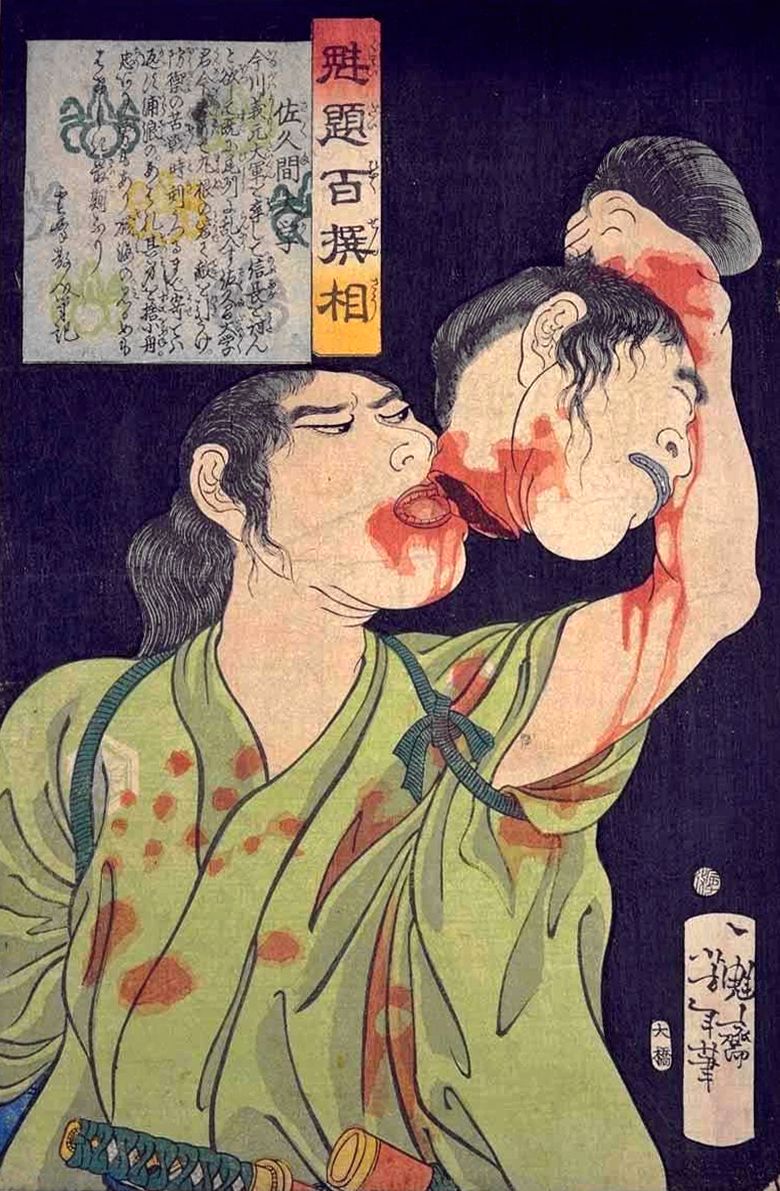
Sakuma Daigaku Drinking Blood from a Severed Head by Tsukioka Yoshitoshi
Yoshitoshi’s Selection of 100 Warriors, printed during the years of the war, represents the violent acts of famous samurai, and features such bloodthirsty work as Sakuma Daigaku Drinking Blood from a Severed Head. The print applied lessons learned in the battlefield, execution ground, and Kuniyoshi’s studio. The debt to Kuniyoshi’s Byôkwansaku Yôyû Gazing at a Severed Head is clear in the hair-clutching and the green kimono (complementary to the red of blood) – but the terrifyingly compelling result is Yoshitoshi’s own. The print traps the eye in a gory loop: from the grimacing mouth of the victim, down the blood trail dripping into Sakuma’s armpit, then back up to the gaping mouth, the gaping neck…The dead and the living are inextricably bound, the winner and loser have almost the same face – two heads like theater masks, differing only in mood.
The image depicted a scene from the 16th-century war between brothers Oda Nobuyuki and Oda Nobunanga; Sakuma Daigaku took the head of Nobuyuki’s general during one of the battles. He doesn’t appear to have drunk his victim’s blood, though his leader Nobunaga did eventually have the skulls of his defeated enemies gilded and turned into sake cups. Perhaps Yoshitoshi combined the two events for dramatic effect. The subject-matter – a war between brothers – echoed the civil war of Yoshitoshi’s own era, while avoiding possible censorship.
Sakuma Daigaku Drinking Blood from a Severed Head is the 20th in a projected Selection of 100 Warriors, but Yoshitoshi would abandon the series by #65. Just as the country was returning to a semblance of peace, the artist would suffer what appeared to be a mental breakdown and fall into a deep depression. During the five years that followed, he had to accept his students’ gifts of rice and pickled vegetables. Once, he burned the floorboards of his home for warmth. To support him, his mistress, Okoto, would sell her possessions and formal clothes. A few years later, she would move back to her hometown, sell herself to a brothel, and send Yoshitoshi the profit.
Yoshitoshi emerged from his five-year hiatus into a changed Japan. Though the pro-imperial samurai had rallied under the slogan “Western technology, Japanese values,” what followed the Meiji Restoration was in fact the dissolution of much that traditional Japan had held dear. Replaced by a conscripted army, the very samurai who had helped overthrow the shogun would soon become obsolete. The same fate was befalling many Edo traditions – including, eventually, woodblock printing, which would be superseded by the Western techniques of lithography and photography.
Yoshitoshi clung to tradition as stubbornly as the samurai fighting at Ueno. He took up time-honored artforms like Noh chanting, abstained from Western technologies like gas lighting, and sang praises to old ways of life in his many historical prints. His work took on a more subdued tone; in addition to near-bloodless warrior prints, he now designed images of beautiful women. His treatment of real women remained appalling, though; around 1878, his second mistress sold her formal clothes and possessions to support him, then contracted herself out to a brothel. Though biographers praise the wife he married in 1884 for her stabilizing influence, Yoshitoshi “did not stop his philandering” after their marriage, Eric van den Ing and Robert Schaap noted in their book, Beauty and Violence: Japanese Prints by Yoshitoshi, 1839-1892.
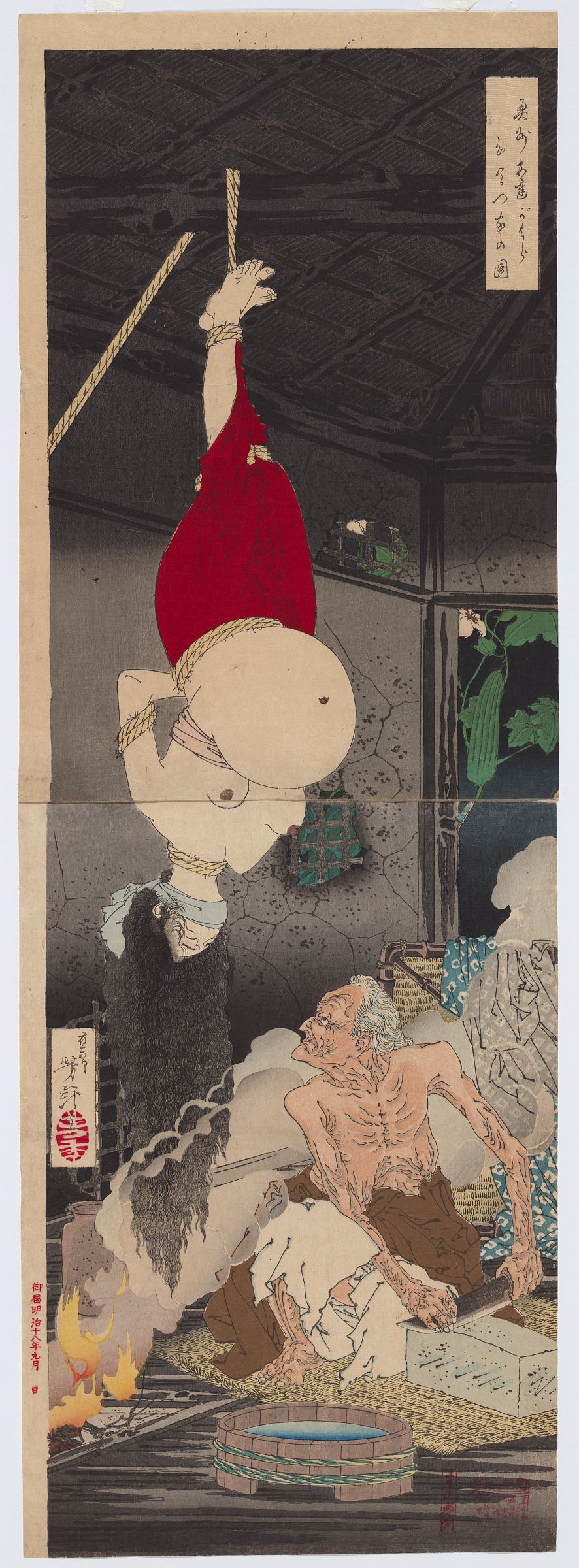
The Lonely House on Adachi Moor by Tsukioka Yoshitoshi
And then, in 1885, he produced perhaps his most bloodcurdling design. In The Lonely House on Adachi Moor, a heavily pregnant woman hangs upside down from the ceiling, her round belly flopping helplessly downwards. Below her, the shriveled hag of Adachi Moor readies a knife to slice open the womb. There might not be any blood (by then, censors wouldn’t allow that), but this print is as haunting as any Yoshitoshi produced.
Yoshitoshi’s Lonely House on Adachi Moor – designed on the 30th anniversary of the Edo earthquake – is strongly indebted to Kuniyoshi’s earlier prints. The flaccid-breasted, bony hag is almost the same; her victim even wears the same red skirt. Still, let’s give Yoshitoshi his due: it’s the innovation of hanging the victim upside down that turns his design into the stuff of nightmares.
As with the teacher, so with the student: prints of the hag heralded the beginning of Yoshitoshi’s final years. She reappeared in one of his last masterpieces: The Actor Onoe Kikugoro V as the Hag of Adachi (1890). The following year, Yoshitoshi invited his friends to meet a group of artists…who turned out to be a figment of his imagination. He spent the next year between several mental health hospitals, then died from a cerebral hemorrhage at 53.
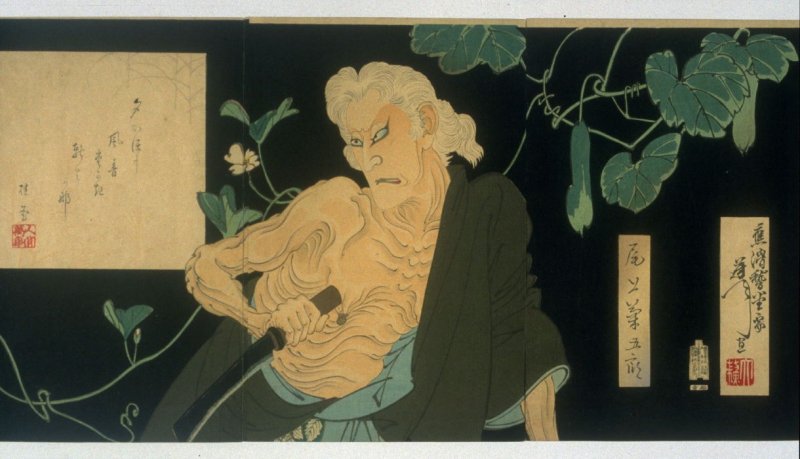
The Actor Onoe Kikugoro V as the Hag of Adachi by Tsukioka Yoshitoshi
Hoping to extend the artistic pedigree which stretched back behind him in unbroken lines of repeated syllables – Yoshitoshi, Kuniyoshi, Toyokuni, Toyoharu – Yoshitoshi trained more than 200 students and gave 60 of them artist names. None of their work passed the test of time; woodblock printing effectively died with its bloodiest proponent.
Like the subjects of his prints, Yoshitoshi had been a “valiant drunken tiger,” risking his life to view the carnage from up close, battling mental illness, bravely and foolishly pushing his medium forward even as it was becoming obsolete. Like the samurai he admired, he was the last of his kind. He was also, by 21st-century consensus, the greatest Japanese artist of his era.
